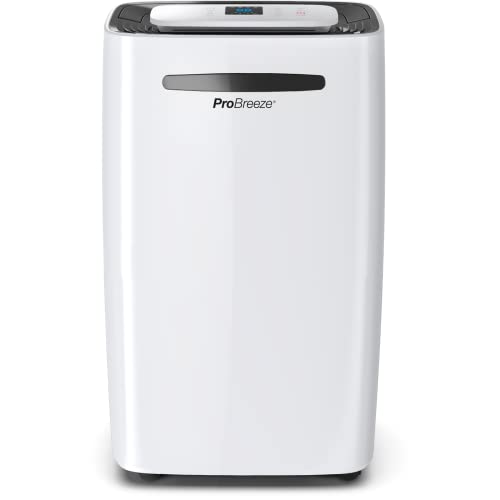I used a dehumidifier to get rid of damp and condensation – and learned some essential expert tips
I reveal how I used a dehumidifier to eliminate damp and condensation in my home – and the three expert tips everyone should follow

When I first started renovating my home, I was ready to take on the challenge of ripping out old carpets and updating a dated kitchen. But what I wasn’t prepared for was the constant battle with condensation on my windows and damp patches spreading across my walls.
Despite all my efforts, it felt like the moisture just kept coming back. After some research, I realised high humidity was the culprit, so I decided to face the problem head-on by investing in a dehumidifier to finally eliminate the damp and condensation for good.
Now, my home is drier, fresher, and infinitely more comfortable. Thanks to the dehumidifier, better ventilation, and a few other key changes, I’ve completely transformed my space. Here’s how I did it – and how you can too.
Pinpointing the problem areas
Damp and condensation aren’t just surface issues. Often, they come from excess moisture hanging around in the air. In my home, the most obvious sign something was wrong was the sheer amount of window condensation I noticed in the mornings. But the damp patches on walls told me the moisture was building up elsewhere too. To figure out where the problem was worst, I kept an eye on:
- Windows: Water droplets were forming on the glass, especially in the mornings.
- Walls: Cold corners and external walls were slightly damp to the touch.
- Clothes: Certain items in my wardrobe felt clammy to the touch, had a musty odour, and I even found mould on a pair of suede shoes.
After plenty of research, I invested in a hygrometer and quickly discovered the cause of my problems: high humidity levels and poor natural ventilation. To tackle the damp and condensation head-on, I realised I needed a three-pronged approach: improving ventilation, insulating my windows with secondary glazing, and finding the best dehumidifier I could get my hands on.

I use a thermo-hygrometer to keep a careful eye on the humidity levels in my home.
How to use a dehumidifier

Although a dehumidifier won't stop mould on its own, I knew it would help me reduce both humidity and moisture levels in my home – two important steps if I wanted to get rid of damp and condensation. So I opted for the ProBreeze 20L Premium Dehumidifier and found the following steps worked best:
- Placement: I put the dehumidifier in the bedroom first, as that’s where the damp was most noticeable. Keeping doors closed made it more effective at targeting the moisture in one space at a time. Eventually, I purchased another dehumidifier to place in my home office and I occasionally rotated these into other rooms, like the kitchen, whenever I was drying laundry inside.
- Settings: I set my unit to maintain a humidity level of 50%, which seemed to hit the sweet spot for reducing condensation without making the air feel too dry.
- Running times: I ran my dehumidifier for about 6-8 hours a day, especially overnight when condensation was at its worst.

This impressive dehumidifier can extract up to 20L of water per day with an extra-large 5.5L water tank which automatically shuts off when full.
Ventilation and other techniques
While the dehumidifier did a lot of heavy lifting, I quickly realised it couldn’t do everything on its own. Ventilation turned out to be just as important in preventing damp and condensation from building up again.
Here are some of the additional steps I took to get on top of these issues:
- Opening windows: I started opening the windows for 10-15 minutes each morning – a technique often referred to as to as house burping – let out the stale, damp air. Even in winter, this small habit made a big difference.
- Using a window vacuum: Condensation on windows was a daily battle, but a window vacuum made it so much easier to remove excess moisture from these surfaces. A simple tool like this window squeegee from Amazon would also work well for this task.
- Extractor fans: In the kitchen and bathroom, I made sure to run extractor fans whenever I cooked or showered. This meant excess moisture wasn't lingering around.
- Drying clothes indoors: This was a major contributor for me. When I had to dry laundry indoors, I placed it near the dehumidifier, which helped absorb extra moisture.
What the expert says
Although these steps made a huge difference in my home, I also sought expert advice from Chris Michael, founder and managing director of Meaco, on using a dehumidifier to get rid of damp and condensation. These were his three top tips:
1. Get your dehumidifier placement right
“For general damp and condensation – place the dehumidifier in a central area such as the landing or hallway. Leave internal doors open and set your dehumidifier to reach a target between 50-55% relative humidity. The dehumidifier will draw moisture in from your whole home (as long as you have chosen the correct size of unit).”
2. Target problem areas
“If you have a problem area, place the dehumidifier closer to that area e.g. if you have a damp problem in a specific bedroom, it would be advisable to put the dehumidifier in that room with the door shut. This will speed up the removal of excess moisture from that room.”
3. Clean the filters every two weeks
"To make sure the dehumidifier works at optimal efficiency, it’s really important the filter is clean every 2 weeks. Lot’s of people forget to do this, which causes dust and dirt to build up in the filer and make its way inside the unit. Cleaning the filter ensures the dehumidifier performs most efficiently and quietly.”

Chris Michael is the Founder of Meaco, a leading expert in dehumidifiers and air quality solutions, dedicated to improving home comfort and indoor environments.
FAQs
Does a dehumidifier fix damp permanently?
Not on its own. While a dehumidifier works by reducing moisture levels, it’s only part of the solution. To permanently fix damp, you’ll need to address the root cause. This could include repairing leaks, improving ventilation, or upgrading home insulation to prevent moisture from returning. For example, check for water ingress around windows, roofs, or exterior walls and seal any gaps.
Can a dehumidifier stop condensation?
Yes, a dehumidifier can be highly effective at stopping condensation by lowering the overall humidity in your home. This means there is less water vapour in the air to settle on cold surfaces like windows, walls, or mirrors. For the best results, pair your dehumidifier with daily practices like wiping down windows with a window vacuum and ventilating your space by opening windows or running kitchen and bathroom extractor fans.
One of the most common dehumidifier mistakes is neglecting to clean and replace filters regularly. This simple upkeep tip is key to keeping your dehumidifier running smoothly and performing at its best – so don't forget to show your unit some love and attention!
Get the Homebuilding & Renovating Newsletter
Bring your dream home to life with expert advice, how to guides and design inspiration. Sign up for our newsletter and get two free tickets to a Homebuilding & Renovating Show near you.

Gabriella is an interiors journalist and has a wealth of experience creating interiors and renovation content. She was Homebuilding & Renovating's former Assistant Editor as well as the former Head of Solved at sister brand Homes & Gardens, where she wrote and edited content addressing key renovation, DIY and interior questions.
She’s spent the past decade crafting copy for interiors publications, award-winning architects, and leading UK homeware brands. She also served as the Content Manager for the ethical homeware brand Nkuku.
Gabriella is a DIY enthusiast and a lover of all things interior design. She has a particular passion for historic buildings and listed properties, and she is currently in the process of renovating a Grade II-listed Victorian coach house in the West Country.
